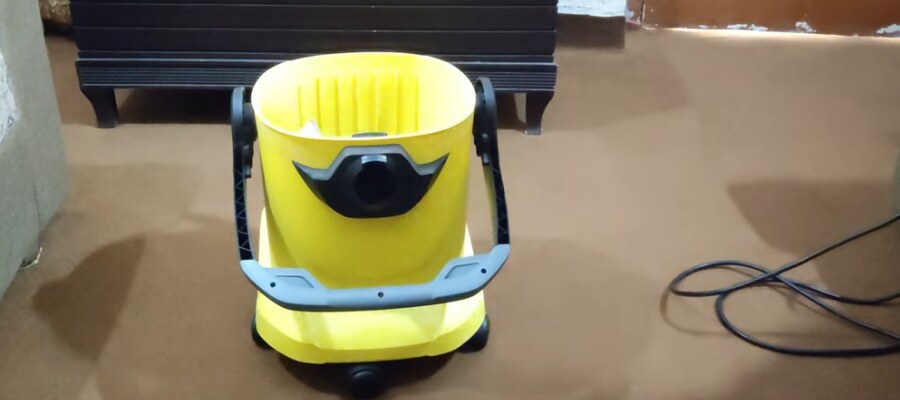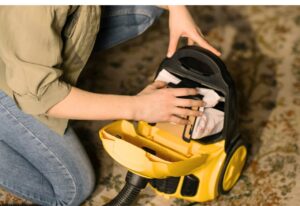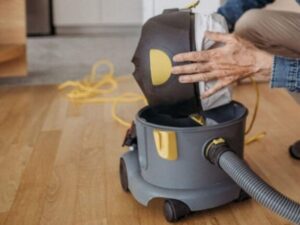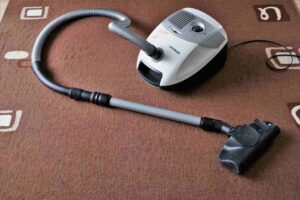Before opening the vacuum cleaner’s dust bag, unplug the vacuum from the power source to ensure your safety. This will help prevent any unexpected accidents, such as the vacuum suddenly turning on or causing a short circuit. Knowing how to open vacuum cleaner dust bag makes the process easier and safer.
Find the bag compartment on upright models via a zippered or latched cover, or on canister models near the hose attachment. Open any clips or latches. Then, slowly pull the part of the bag that is attached to the hard section. Be careful not to let dust spread around.
Before using the vacuum cleaner, read the specific manual for its model so that you can use it correctly and safely.
Table of Contents
Introduction
The dust bag of the vacuum cleaner may seem like a simple task, but if not done correctly, it can reduce the vacuum’s performance and spread dust and debris around your home. If the dust or dirt bag of the vacuum cleaner is not emptied in time, or if it is not used properly, then the suction power of the vacuum may decrease.
As a result, the vacuum’s motor may have to use more energy, and allergens present in the dust can spread into the air. This is why your cleaning task may not be successful.
Whether you’re using a disposable bag on an upright vacuum or managing a reusable bag in a canister model, this guide is very useful for you.
The Role of Vacuum Dust Bags in Maintaining a Clean Home
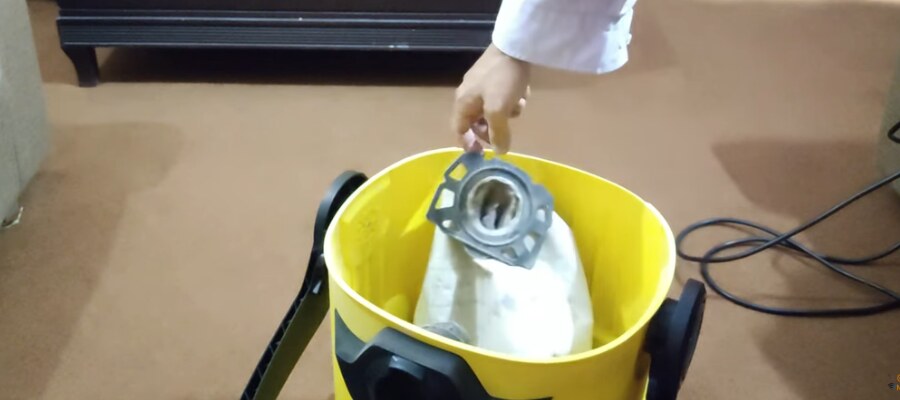
Vacuum dust bags are not only a place to store dirt but also an important part of your vacuum’s cleaning system. They trap dust, pet hair, and allergens, ensuring your home stays fresh and healthy. When a bag is full or improperly handled, it can lead to:
- Weak Suction: Blocked airflow reduces your vacuum’s ability to pick up dirt and debris. Sometimes, weak suction may not only be due to a full bag; you may also need to replace the vacuum belt.
- Motor Overload: A clogged bag forces the motor to work harder, risking burnout.
- Allergen Spread: Dust and allergens can leak during removal, affecting air quality.
- Equipment Longevity: Proper bag care extends your vacuum’s lifespan.
If you understand how to properly open and use your dust-filled bag, you can avoid these problems. As a result, your room will stay clean, and a healthy environment will be maintained.
What You’ll Need Before Starting
- Protective gloves
- A face mask
- A trash can or garbage bag
- An old sheet or tarp
- A damp cloth with mild dish soap
- A replacement dust bag
- A small brush or pipe cleaner
- Your vacuum’s owner manual
If you prepare some necessary things in advance, you can simply manage any unexpected situation.
How to Open a Vacuum Cleaner Dust Bag Easily and Safely
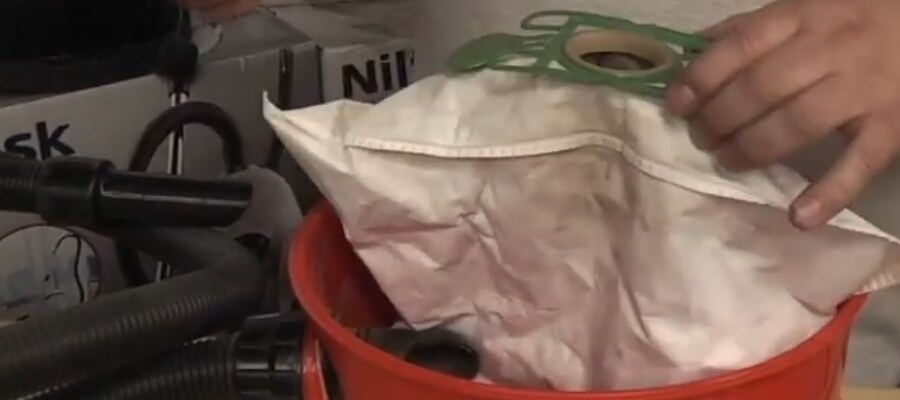
These steps will guide you through opening and removing your vacuum cleaner dust bag safely and efficiently. Both model has different rules, so it is advisable to refer to the manual to avoid mistakes.
Step 1: Set Up a Clean Workspace
To prevent dust from spreading in the house, do the work in an open or well-ventilated area. And yes, if any dirt splatters, lay down an old sheet or tarp on the floor to catch it. Working outdoors or in a garage is ideal, but a kitchen or utility room works too. Keep a dustbin or bag nearby for quickly disposing of dirt, dust, or old parts.
Step 2: Disconnect Power for Safety
Before opening or repairing the vacuum cleaner, always make sure it is completely disconnected from the electrical socket. This can prevent any accidents. There is no risk of accidental start-up or electric shock even if the plug is left plugged in, especially when it is cleaned with a wet cloth.
Step 3: Find the Dust Bag Compartment
The bag compartment’s location depends on your vacuum type:
- Upright Vacuums: Often behind a zippered panel or latched cover on the front or side.
- Canister Vacuums: Typically near the hose connection, inside a plastic or metal housing.
- Robot Vacuums: Some, like Eufy’s self-emptying models, have dust bags in a docking station, accessed via a top lid.
Step 4: Access the Compartment
Carefully release the latch, zipper, or clips to open the compartment. Some models have a simple push-button, while others require sliding or twisting a cover. If it gets stuck, don’t force it—see the troubleshooting section for solutions.
Step 5: Remove the Dust Bag
Grip the bag’s cardboard or plastic collar, which connects to the vacuum’s suction port. Softly pull it apart and keep the bag upright to prevent the liquid from spilling. For disposable bags, close the sealing flap to trap dust. For reusable bags, cover the opening with your hand to keep out dirt.
Step 6: Handle Disposal or Emptying
- Disposable Bags: Place the bag in a garbage bag and seal it tightly. Dispose of it in an outside trash bin to avoid indoor dust spread.
- Reusable Bags: Please dump the discarded items into a trash bag, preferably outside. If the bag is washable, then wash it with warm water and a mild soap. This will clean all the dirt or debris from the bag. Air dry thoroughly to prevent mold.
Step 7: Clean the Compartment
Wipe the room with a damp cloth and a drop of dish soap to remove any remaining dust. Focus on the exploitation port, where debris usually collects. Use a small brush or pipe cleaner for tight spots. Let the compartment dry completely before inserting a new or cleaned bag.
Step 8: Reassemble and Test
Use a new disposable bag or carefully put the cleaned old bag into the suction port. If you are not sure how to change the vacuum cleaner’s dust bag, then this step will help you do it correctly and cleanly. Secure the compartment cover, ensuring all latches are locked. Plug in the vacuum and run it briefly to check for proper suction and any leaks.
How to Solve Common Issues
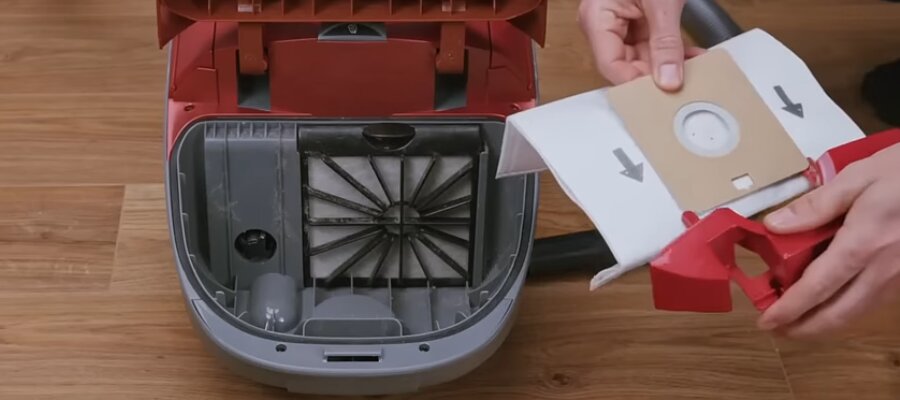
Even with careful steps, issues can arise. Here’s how to address common challenges when opening a vacuum dust bag.
Can’t Find the Compartment
If you cannot understand where the different parts of the vacuum are, check the manual or search online for images using the model number. The dust bag of the Eufy L60 robot vacuum is located under a cover on top. You will see labels such as ‘Dust Bag’ or ‘Collection Chamber’ there. When you open the cover, you will find the bag that holds the dust. This vacuum can empty the dust automatically.
Stuck Latches or Covers
Dust or debris can jam latches. Clean around the latch with a damp cloth or brush to loosen it. If it’s still stuck, then slowly wiggle the latch while applying light pressure. Forcing it risks breaking the mechanism contact the manufacturer.
Dust Leaks During Removal
Spills happen with overfilled or torn bags. Hold the bag over a trash can during removal and move slowly. If dust comes out, clean it with a shop vac or a wet cloth. Wear a mask to avoid inhaling particles.
Torn Bags
If the bag tears, stop and place it in a garbage bag to contain the mess. Clean the part of the vacuum where dirt accumulates well. Then, check carefully to see if any sharp or pointed objects could tear the bag or pipe. Smooth any rough spots with fine sandpaper.
Also, if your vacuum hose has any cracks or leaks, it can reduce suction and create similar issues. Here is how to repair your vacuum cleaner hose.
Wrong Bag Installation
Using the wrong bag may reduce the leak or suction. Check the manual or package to verify if it matches the model.
Maintenance Tips for Optimal Vacuum Performance
Regular care keeps your vacuum efficient and long-lasting. Here are practical tips for dust bag maintenance and beyond.
Monitoring Bag Capacity
Check the bag every 4-8 weeks. However, if there are pets in the house or a lot of people are coming and going, check it more frequently. Replace disposable bags when two-thirds full to maintain airflow. Empty reusable bags after each use or when half-full to prevent clogs.
Caring for Reusable Bags
Reusable bags should be washed with warm water and mild soap after use. Avoid harsh chemicals, which can weaken the fabric. Air dry completely to prevent mold or motor damage. Some bags can be washed in a washing machine, but you need to use the machine’s ‘delicate’ setting. So make sure to check the manual carefully first.
Keeping the Compartment Clean
Wipe the compartment monthly with a damp cloth to remove dust buildup. Clear the suction port with a pipe cleaner to ensure unobstructed airflow. If the bend or gasket is damaged, the suction may decrease. Check them occasionally to ensure they are in good condition.
Filter and Hose Care
Clean filters complement a well-maintained bag. Rinse washable filters every 1–3 months and replace non-washable ones every 3–6 months. Clear hose clogs with a broom handle or flexible rod to maintain suction power.
Debunking Vacuum Dust Bag Myths
Misinformation can lead to improper vacuum care. Let’s see what common misconceptions people generally have about dust bags.
Myth 1: Full Bags Are Fine to Keep Using
A full bag restricts airflow, reducing suction and straining the motor. Replace or empty bags when two-thirds full to avoid performance issues or damage.
Myth 2: Any Bag Fits Any Vacuum
Bags are model-specific. Using the wrong bag can cause leaks or motor strain. Always use bags recommended by your vacuum’s manufacturer.
Myth 3: Reusable Bags Don’t Need Cleaning
Neglected reusable bags harbor mold and odors. Clean them regularly with soap and water to maintain performance and air quality.
Myth 4: Dust Bags Don’t Impact Allergies
Dirty or overfilled bags can release allergens during removal, worsening respiratory issues. Proper handling and timely replacement keep allergens at bay.
Health and Safety Tips for Handling Dust Bags
Opening a dust bag involves health and safety considerations. Here’s how to protect yourself.
Minimizing Allergen Exposure
Dust bags can release fine particles that trigger allergies or asthma. So, wear an N95 mask and gloves during removal, especially if you’re sensitive to dust. Work outside or in a well-ventilated area to reduce exposure.
Preventing Electrical Risks
Before opening the compartment, unplug the vacuum to ensure safety. Using a damp cloth near powered components risks shock. Ensure the vacuum is off and dry before reassembling.
Proper Dust Disposal
Seal disposable bags in a garbage bag before tossing them to prevent dust leaks. Empty reusable bags into a sealed trash bag and place it in an outside bin to keep your home clean.
Frequently Asked Questions (FAQ)
How often should I check or replace my vacuum bag?
If you use bags often, check them regularly. If they are disposable, throw them away when full; and if they are reusable, empty them after use or when they are half full.
Is it safe to reuse disposable bags?
No, disposable bags are for one-time use only. Reusing them carries the risk of tearing, leaking, and decreased airflow. If you prefer a reusable option, choose reusable bags.
What if my bag tears during removal?
Place the torn bag in a garbage bag immediately. Clean the compartment with a damp cloth and vacuum spills with a shop vac. Check the exploitation port for sharp edges.
How do I identify reusable vs. disposable bags?
Disposable bags have a cardboard collar and sealing flap, while reusable bags are fabric and are often washable. Check your manual or bag packaging for confirmation.
Why does my vacuum smell after opening the bag?
Odors come from trapped organic matter, like pet hair or food debris. Regularly empty the bags and clean the compartment with a vinegar solution to neutralize the smell.
What if my vacuum is bagless?
Bagless vacuums use a dust canister. After each use, throw it in the trash. Every few months, wash it with soap and water following the instructions in the manual
How do I replace vacuum cleaner dust bag properly?
First, unplug the vacuum cleaner to stay safe. Then, open the bag compartment and slowly remove the old dust bag. Slide the new bag into the suction port until it fits properly. Make sure no dust can leak out. Now your vacuum will work well and keep your home clean.
Final Thought
Opening the vacuum cleaner’s dust bag may seem like a small task, but it is an important one. It helps the vacuum run efficiently and keeps your home free of dust and allergens. By following these steps, troubleshooting issues, and maintaining your vacuum regularly, you can ensure efficient cleaning and a healthier living space.
This guide will help you handle dust bags on all types of vacuums—whether upright or robot. Keep this resource handy for your next vacuum maintenance, and keep your home clean and fresh, with minimal hassle.

Welcome to Homenias, I’m Jaman M, and I’m here to help you discover the best home products. With years of experience, they offer genuine reviews and helpful guides. Their mission is to make your choices easier. It’s organizing your space or finding creative solutions. Explore how the right products can enhance your everyday life. Don’t miss out on finding the best home products to raise your living experience.

